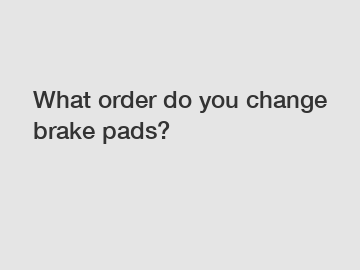What order do you change brake pads?
What order do you change brake pads?
Changing brake pads is an essential maintenance task that should be done regularly to ensure the safety and optimal performance of your vehicle. If you are wondering what order you should follow when changing brake pads, this article will provide you with a step-by-step guide to ensure a smooth and effective process. So let's delve into the topic and explore the proper order for changing brake pads!
1. Gather the necessary tools and materials:

Before initiating the process of changing brake pads, it is essential to have all the required tools and materials. These typically include a jack, jack stands, lug wrench, brake fluid, a C-clamp or brake piston tool, and, of course, the new brake pads. Ensuring that you have everything at hand will not only save you time but also prevent any unnecessary delays during the process.
2. Safely lift and secure your vehicle:
To begin the brake pad replacement, it is vital to ensure the safety of yourself and your vehicle. Find a flat, level surface and use a jack to lift the car. Place jack stands under the vehicle to secure it in the elevated position. Double-check that the stands are properly positioned and stable to avoid accidents.
3. Remove the wheels:
With the vehicle securely elevated, use a lug wrench to loosen and remove the wheel nuts. Carefully take off the wheels one by one, ensuring not to damage or scratch them during the process. Set the removed wheels aside in a safe place.
4. Access the brake caliper assembly:
To access the brake caliper assembly, you may need to remove the protective caps or clips covering the bolts. Once exposed, use an appropriate socket or wrench to loosen and remove the bolts holding the brake caliper in place. Loosen the bolts gradually, alternating between them until they are completely removed.
5. Remove the old brake pads:
After loosening the bolts, carefully lift the brake caliper assembly, taking care not to strain the brake hose. Once lifted, you will be able to see the old brake pads in place. Remove both the inner and outer brake pads from the caliper bracket, being mindful not to damage the brake rotor surface.
6. Inspect and clean the brake caliper:
With the old brake pads removed, inspect the brake caliper for any signs of damage or wear. Ensure that the components, such as the brake piston, are clean and functioning properly. If necessary, clean the caliper with brake cleaner and a brush to remove any dirt or debris.
7. Install the new brake pads:
Before installing the new brake pads, it is essential to prepare them properly. Some pads may require a layer of brake pad lubricant on the backing plates to prevent squeaking. Ensure that the new pads have the same orientation as the old ones and slide them into place. Make sure they are properly seated in the caliper bracket.
8. Compress the brake piston:
Before reattaching the brake caliper assembly, the brake piston must be compressed. This can be done using a C-clamp or a brake piston tool. Align the tool with the caliper piston and gradually apply pressure to compress it. Be careful not to apply too much force, as it could damage the piston.
9. Reattach the brake caliper assembly:
Once the piston is compressed, carefully lower the brake caliper assembly over the new brake pads. Line up the bolt holes with the caliper bracket and reinstall the bolts. Tighten them securely, ensuring not to overtighten. Replace any protective caps or clips that were removed earlier.
10. Repeat the process for the other brake pads:
Following the same steps, repeat the process for the remaining brake pads on the vehicle. Ensure that you maintain the same order and orientation as in the previous steps.
11. Reinstall the wheels:
With all the new brake pads properly installed, you can now put the wheels back on. Align the wheel studs with the lug holes, and hand-tighten the lug nuts to secure the wheel. Once all the wheels are back in place, use a lug wrench to tighten the nuts further, following a star or cross pattern to ensure even torque.
12. Lower the vehicle and test the brakes:
Using the jack, carefully lower the vehicle until all four wheels are on the ground. Once the vehicle is back to its normal position, give each wheel a final tightening of the lug nuts. Start the car and gently press the brake pedal a few times to ensure the brake pads have settled correctly.
In conclusion, if you are wondering about the proper order to change brake pads, following a methodical step-by-step process is crucial. By gathering the necessary tools, safely lifting and securing your vehicle, and carefully following each point outlined above, you can successfully replace your brake pads. Remember always to prioritize safety and consult your vehicle's manual for any specific instructions. Happy servicing and enjoy the peace of mind that comes with well-maintained brake pads!
If you want to learn more, please visit our website toyota oem brake pads vs aftermarket, Drum Brake Shoes Manufacturer, low-metallic brake pad supplier.


